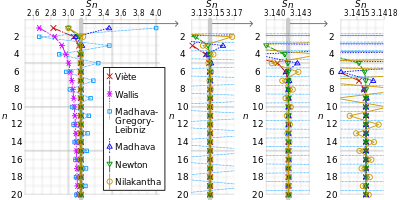Wallis product
In mathematics, the Wallis product for π, published in 1656 by John Wallis,[1] states that

Proof using integration
Wallis derived this infinite product as it is done in calculus books today, by examining for even and odd values of , and noting that for large , increasing by 1 results in a change that becomes ever smaller as increases. Let[2]
(This is a form of Wallis' integrals.) Integrate by parts:
This result will be used below:
Repeating the process,
Repeating the process,
- , from above results.
By the squeeze theorem,
Proof using Euler's infinite product for the sine function
While the proof above is typically featured in modern calculus textbooks, the Wallis product is, in retrospect, an easy corollary of the later Euler infinite product for the sine function.
Let :
Relation to Stirling's approximation
Stirling's approximation for the factorial function asserts that
Consider now the finite approximations to the Wallis product, obtained by taking the first terms in the product
where can be written as
Substituting Stirling's approximation in this expression (both for and ) one can deduce (after a short calculation) that converges to as .
Derivative of the Riemann zeta function at zero
The Riemann zeta function and the Dirichlet eta function can be defined:[1]
Applying an Euler transform to the latter series, the following is obtained:
See also
- John Wallis, English mathematician who is given partial credit for the development of infinitesimal calculus and pi.
- Viète's formula, a different infinite product formula for .
- Leibniz formula for π, an infinite sum that can be converted into an infinite Euler product for .
- Wallis sieve
Notes
External links
- "Wallis formula", Encyclopedia of Mathematics, EMS Press, 2001 [1994]
- "Why does this product equal π/2? A new proof of the Wallis formula for π." 3Blue1Brown. April 20, 2018 – via YouTube.